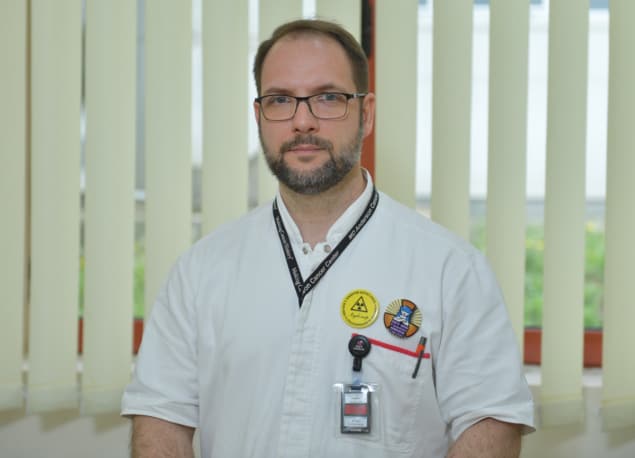Medical physicists at the University Clinical Centre of Serbia depend on the RadCalc Gamma Knife software module to verify their SRS treatment plans

Independent patient QA is hard-wired into the stereotactic radiosurgery (SRS) programme at the National Gamma Centre, part of the University Clinical Centre of Serbia in Belgrade. As such, a core building block of the daily radiosurgery workflow is LAP’s RadCalc QA secondary check software, a suite of widely deployed QA tools that provides radiation oncology teams with automated and independent dosimetric verification of their radiotherapy treatment planning systems (TPS).
Operationally, the heart of the Belgrade clinic’s SRS programme is Elekta’s Leksell Gamma Knife Perfexion treatment system (using GammaPlan TPS version 10.2.1). “Our Gamma Knife Perfexion machine provides intracranial radiosurgery to around 750 patients every year,” explains Ljubomir Kurij, the facility’s chief medical physicist. “We address a wide range of disease indications spanning benign and malignant tumours – including brain metastases, vestibular schwannoma and meningioma – as well as vascular disorders in the brain.”
For context, the Gamma Knife exploits multiple narrow beams of gamma radiation from different directions to deliver conformal, high-dose radiation to the disease target in one or a few fractions while minimizing collateral damage to surrounding healthy tissue and organs-at-risk (OARs). Despite widespread deployment in cancer centres worldwide, it’s fair to say that the precision targeting inherent to SRS remains a non-trivial dose optimization challenge for the medical physics team – and not least when it comes to focusing “high-payload” radiation onto metastatic lesions (as small as 2 mm in extent) and having it fall off as quickly as possible.

RadCalc adds in vivo dosimetric verification, intelligent automation for independent QA
Hence the requirement for independent verification and QA of those GammaPlan treatment plans. “We needed a commercial second-check software product because developing our own in-house solution would have been too time-consuming,” explains Kurij. “To be honest, we were blown away by the functionality of the RadCalc Gamma Knife module when we road-tested the trial version last year. Training overhead is also minimal – RadCalc’s intuitive interface means it takes just a couple of hours to set up the software and get to grips with the main functionality.”
A virtual QA machine
In terms of specifics, the RadCalc Gamma Knife module includes a comprehensive machine configuration and knowledgeable technical support to guide the clinical user through installation and integration. With automated import, calculation and reporting as standard, the software computes the dose and percent difference for each target utilizing proprietary tissue-maximum-ratio (TMR) data, OAR data and source position information supplied by Elekta – in effect, providing a “virtual machine” for the dose computation (with no physics set-up necessary and automatic selection of the data based upon the type of plan). What’s more, RadCalc performs point-dose calculations for the Model 4C, Perfexion and Icon Gamma Knife treatment units using v10 or v11 variants of the GammaPlan TPS.

“We use the RadCalc Gamma Knife software on a daily basis to verify all of our SRS treatment plans,” explains Kurij. So far, across a cohort of well over 400 patients, Kurij and his team of three medical physicists have seen no significant discrepancy versus the primary dose calculations in Gamma Plan (more than 1.5% in only three cases).
“All the same,” he notes, “RadCalc gives us that added level of reassurance versus the TPS. Before RadCalc, we had no way of checking the GammaPlan dose calculations were correct without doing a QA measurement with a phantom – i.e. interrupting the SRS workflow and taking a hit on our patient throughput.”
That reassurance, in turn, hinges on the independence of the RadCalc Gamma Knife module and its calculation algorithm from the SRS treatment system. As such, RadCalc stores and maintains its own copy of the Elekta proprietary data, with the table look-up and interpolation process also separate from Elekta’s. In addition, external contour determination (from skull scalar-instrument measurements or threshold CT images) is fully independent as are the ray-tracing process for depth determination and the off-axis computation of the dose.

Using RadCalc to verify Gamma Knife treatment plans
For Kurij, other notable features of RadCalc are the software’s powerful search and reporting tools – which make it straightforward to view which treatment plans have been approved by the clinician or physicist – as well as the user-friendly visualization tools. “The software has a neat visual representation of the target volume, so you can see where the beams are entering the patient’s skull,” he notes. “That’s important because if the RadCalc dose calculation deviates significantly from the GammaPlan calculation, it’s usually because the target is located in close proximity to the surface of the skull – allowing corrective measures to be taken if necessary.”
- For more information about RadCalc, sign up for the webinar Experience of transit dosimetry using RadCalc EPID on 25 May, and visit LAP on booth 10 at the ESTRO Annual Congress in Vienna, Austria (12-15 May).




